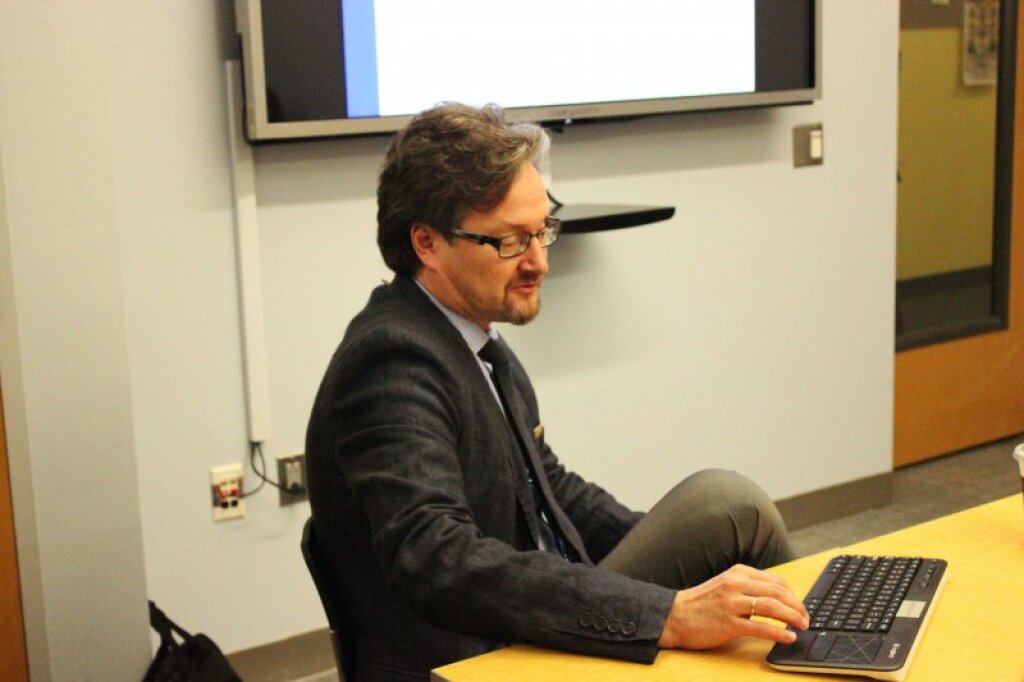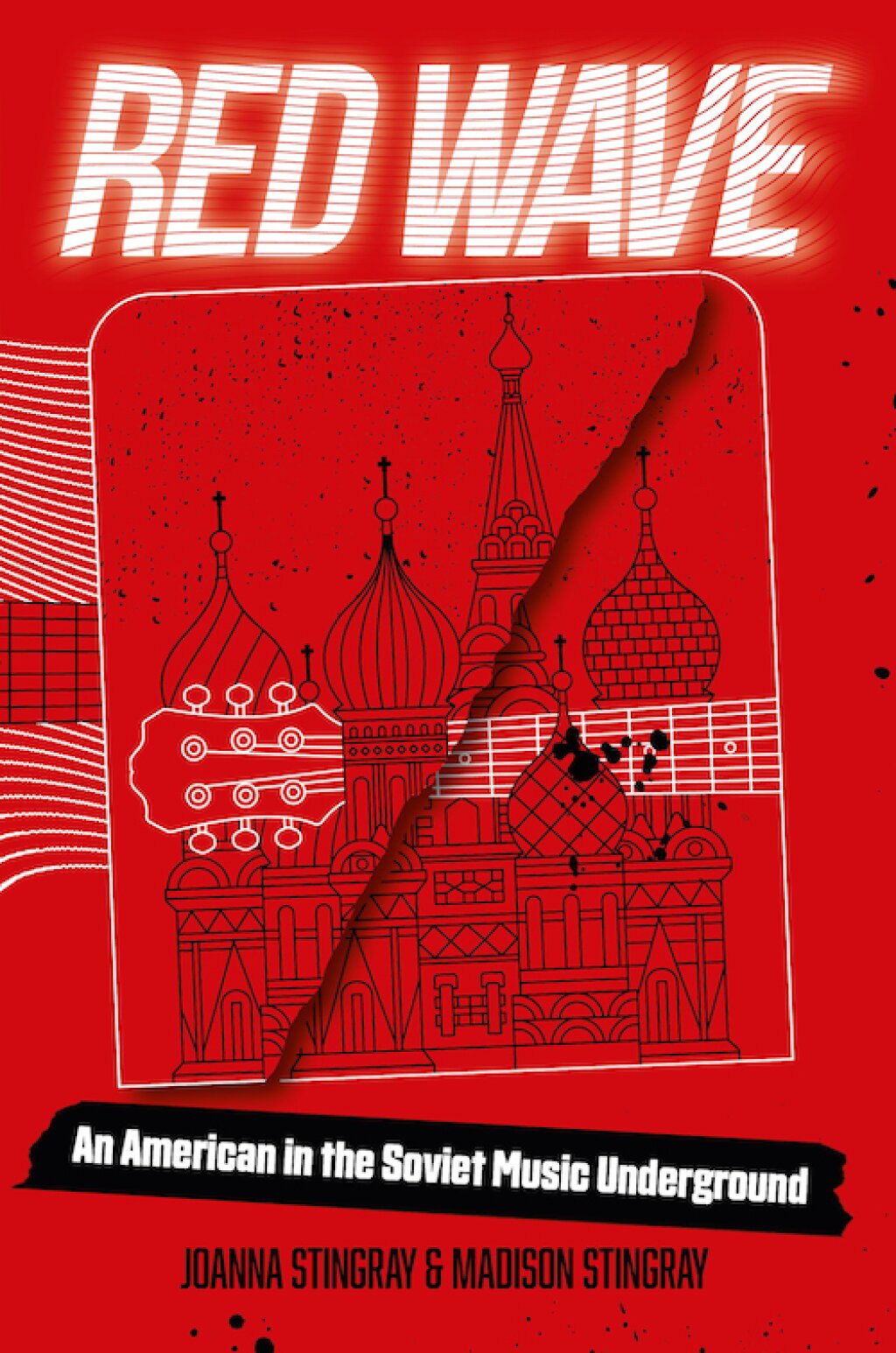Watch the video of the event here
On October 30, 2015, the NYU Jordan Center for the Advanced Study of Russia welcomed visual artist Daniel Mellis and Russian-American poet and translator Eugene Ostashevsky to speak on their ongoing reproduction and English translation of Vasily Kamensky’s Tango with Cows. The book, which contains six of his ferroconcrete poems, was originally published in Moscow in the spring of 1914.
During the talk, Mellis and Ostashevsky gave a historical context for Tango with Cows, which was published during the same period as “Zang Tumb Tumb,” a poem by the Italian Futurist Filippo Tommaso Marinetti, and Guillaume Apollinaire’s first calligrammes. Similar to the modern zine genre, works by the futurists were experimental and often crude. The futurists claimed that “Pushkin was as incomprehensible as hieroglyphics,” Mellis said. They “rejected the recent literary past […] and their rejection carried over to the physical forms of their books.” Futurist publications could be made into collages, printed with rubber stamps, lithographs, hectographs or hand-printed.
Futurist art and literature also reflected modern life in the early 20th century. The themes of Tango with Cows are urban—there are poems about airplanes, telephones, movies, modern art, and roller skating. Mellis pointed out that while using lithography to print Tango with Cows would have been cheaper, Kamensky used the letterpress, the dominant method in the West for printing advertisements. In fact, Tango with Cows is a prime example of how advertising “often anticipates and inspires experimentation and the avant-garde,” he said.
Tango with Cows was published only a few months after the tango craze hit Russia, and Ostashevksy said that tango and futurism are inextricably linked. At the beginning of the 20th century, tango was considered “the endless, continuous dance of modernity that is in the rhythm of the factories and machinery,” he said. Tango with Cows itself is deeply embedded in that culture and also “tremendously avant-garde.”
Mellis also spoke about the digital reconstruction of the booklet, a text that he called “a key document in visual typography.” The original book was printed on the back of yellow wallpaper and bounded by staples. It contains 65 different fonts, all of which were typeset from metal and wood type meant for Roman, rather than Cyrillic typefaces.
In discussing his reproduction of the book, Mellis noted a few peculiarities that could lend insight to our understanding of Kamensky’s process. “It seems like the book is trying to be Western and forward-thinking in its typography, but the typographic variety might also be based just on who they could find to print it,” he said. The original frequently replaces zeros with “O’s,” contains spacing mistakes and many of its bigger typefaces are damaged. “It would have been expensive to pay for the composition because it was [a] very complicated typesetting,” Mellis concluded, based on the low standards of printing in the book.
Mellis said that he “wanted to recreate the materiality of the original” but that “it is difficult to recreate the bad printing in the exact same way.” For the typeface, he used a digital facsimile to sort every style of font in the book by size, which gave him a sense of how the book was made. He then found specimen books that contained the same type so he could accurately recreate the English translation. As Mellis passed around pre-release copies of the book, he noted that “digital typography hasn’t really caught up with metal,” the material used in the typesetting of the original Tango with Cows.
After the audience had the chance to leaf through copies of the book, Ostashevksy spoke about the language of the text as a piece of visual poetry and its close relationship to the art of the 1910s, a connection that he said many scholars do not recognize. “Tango with Cows is a text that is quite closely connected to the use of words in cubist, futurist, and avant-garde painting,” he said. Ostashevsky related his study of Mikhail Larionov, who often included graffiti, scatological phrases, and stenciled letters in his paintings. Other works by Larionov cut words off, producing a semantic ambiguity. For example, Ostashevsky showed how Larionov’s Portrait of a Prostitute (1913) uses three letters in two possible ways; one configuration means “three rubles” and another shortens a word to mean “whore.”
Ostashevsky then discussed the text of Tango with Cows, which contains a plethora of signs of modernity and quantifications including telephone numbers, license plate numbers, and prices. A line of zeros, for instance, is a reference to a roller skating rink—not just in the roundness of the zero, but also in how it sounds. “It’s very futurist in the Italian sense because it’s [a] multidimensional, visual work that’s also a work about sound,” Ostashevsky said. In other parts of the text, there are “matrioshka rhymes,” a kind of echo-rhyme developed by Kamensky, which Ostashevksy added are very difficult to translate.
In the Q&A session that followed, Mellis and Ostashevksy were able to expand on the translation process and the digital recreation of Tango with Cows. Russian and Slavic Studies Department Chair Anne Lounsbery questioned the deliberate crudeness of the production of “Tango with Cows,” relating the book to the work of English poet William Blake who often deliberately reproduced mistakes.



